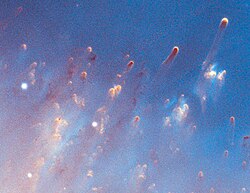Comets Kick up Dust in Helix Nebula (PIA09178)
The nebula, located about 700 light-years away in the constellation Aquarius, belongs to a class of objects called planetary nebulae. Discovered in the 18th century, these colorful beauties were named for their resemblance to gas-giant planets like Jupiter.
Planetary nebulae are the remains of stars that once looked a lot like our sun. When sun-like stars die, they puff out their outer gaseous layers. These layers are heated by the hot core of the dead star, called a white dwarf, and shine with infrared and visible colors. Our own sun will blossom into a planetary nebula when it dies in about five billion years.
In Spitzer's infrared view of the Helix nebula, the eye looks more like that of a green monster's. Infrared light from the outer gaseous layers is represented in blues and greens. The white dwarf is visible as a tiny white dot in the center of the picture. The red color in the middle of the eye denotes the final layers of gas blown out when the star died.
The brighter red circle in the very center is the glow of a dusty disk circling the white dwarf (the disk itself is too small to be resolved). This dust, discovered by Spitzer's infrared heat-seeking vision, was most likely kicked up by comets that survived the death of their star. Before the star died, its comets and possibly planets would have orbited the star in an orderly fashion. But when the star blew off its outer layers, the icy bodies and outer planets would have been tossed about and into each other, resulting in an ongoing cosmic dust storm. Any inner planets in the system would have burned up or been swallowed as their dying star expanded.
So far, the Helix nebula is one of only a few dead-star systems in which evidence for comet survivors has been found.
This image is made up of data from Spitzer's infrared array camera and multiband imaging photometer. Blue shows infrared light of 3.6 to 4.5 microns; green shows infrared light of 5.8 to 8 microns; and red shows infrared light of 24 microns.| This file is in the public domain in the United States because it was solely created by NASA. NASA copyright policy states that "NASA material is not protected by copyright unless noted". (See Template:PD-USGov, NASA copyright policy page or JPL Image Use Policy.) |  | |
 |
Warnings:
|
Relevantní obrázky
Relevantní články
Planetární mlhovina HelixPlanetární mlhovina Helix je pravděpodobně nejbližší a současně také nejjasnější planetární mlhovina na obloze. Objevil ji Karl Ludwig Harding v roce 1824. Nalezneme ji v souhvězdí Vodnáře (Aquarius). Má zdánlivou jasnost 7,3m, úhlový rozměr jasné části 16´ a je od nás vzdálená přibližně 450 světelných let. Svým tvarem se podobá Prstencové mlhovině a mlhovině Činka, přičemž mlhovina Činka má podobnou velikost a stáří, ale díváme se na ni pod jiným úhlem, a Prstencová mlhovina má velmi podobný vzhled, ale nachází se v mnohem větší vzdálenosti, je značně menší a mladší. .. pokračovat ve čtení
Věda na ZeměplošeVěda na Zeměploše je zvláštní knihou z Pratchetovy série příběhů o Zeměploše. Děj této knihy probíhá ve dvou rovinách, Terry Pratchett rozvíjí svůj příběh o pokusu mágů na Neviditelné univerzitě v Ankh-Morporku a současně druzí dva autoři, Ian Stewart a Jack Cohen popisují pohled naší současné astrofyziky a biologie na vznik a vývoj vesmíru a života. .. pokračovat ve čtení
Kometární jádroKometární jádro je pevné těleso nacházející se uprostřed komety. Kometární jádro je obvykle složené z prachu, zmrazených plynů a kamene. Populárně jsou označované za „špinavé sněhové koule“. Plyny sublimují při zahřátí Sluncem a vytváří plynný obal, obklopující a následující kometární jádro jinak označovaný za koma. Síla účinkující vlivem sluneční radiace a solárního větru na koma při přiblížení komety k Slunci způsobuje vytvoření kometárního ohonu, který směřuje dál od Slunce. Typické kometární jádro vykazuje albedo 0,04. Tato hodnota je nižší než u uhlí a pravděpodobně je způsobena povrchovým prachem. Získané informace ze sond Rosetta a Philae poukazují na nepřítomnost magnetického pole v okolí jádra komety 67P/Čurjymov-Gerasimenko. Z tohoto poznatku se odhaduje, že síla magnetického pole a magnetismu obecně nehrála velkou roli v době brzké formace planetesimál. .. pokračovat ve čtení











